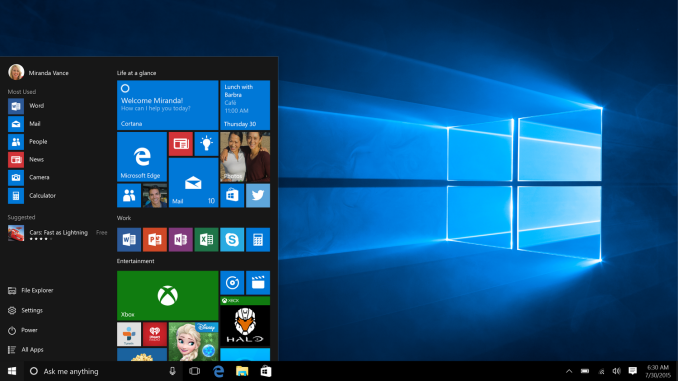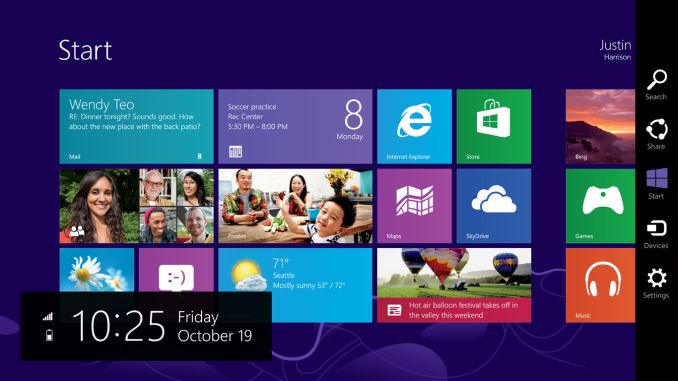The Windows 10 Review: The Old & New Face of Windows
by Brett Howse on August 25, 2015 8:00 AM EST- Posted in
- Operating Systems
- Microsoft
- Windows 10

Let’s flash back to 2012. About three years ago, Windows 8, the last major release of Microsoft’s ubiquitous operating system, was released to manufacturers. This was to be Microsoft’s most ambitious release yet. Traditional PC sales were in decline, and more personal devices such as the iPad tablet were poised to end the dominant PC platform. Microsoft’s response to this was to change Windows more than in any previous release, in a bid to make it usable with the tablet form factor. Windows 8 launched in October 2012 to much fanfare.
There was much fanfare, but little in the way of sales. Yes, Microsoft did sell many copies of Windows 8, but it did not help the declining PC market rebound. Windows 8 came to be with a touch first interface, with a new Start Screen replacing the traditional Start Menu, and a new breed of Windows 8 apps, which run on the WinRT framework. These WinRT apps have been named many things over the past three years, starting with Metro apps. A trademark dispute ended that naming scheme though, and over time they have morphed from full screen apps to universal apps to Windows Store apps, and practically none of them were able to rival the older Win32 platform in popularity or productivity.
Windows 8 did bring some great features to Windows, but they were overshadowed by the major design shift which, while good as a touch based operating system, alienated many who still used Windows on a traditional desktop or notebook. The Start Screen was a big turn off to many people, and full screen apps were not very efficient on a large screen display. Even the multitasking in Windows 8 was less than ideal, with the initial release only allowing two Windows Store apps to be open at any one time, and the second was relegated to a small side bar.
Microsoft’s own faith in Windows 8 was clearly not strong. Only a couple of weeks after Windows 8 launched, they unceremoniously dumped the project head Steven Sinofsky from the company, and spent the next two years trying to make Windows 8 more usable on traditional mouse and keyboard type machines, which were the vast majority of Windows devices in the hands of users. Windows 8.1 arrived and fixed some of the key issues with Windows 8, and 8.1 Update launched with the ability to boot to the desktop, and avoid the touch interface almost completely if you wanted to.
 Windows 10 Start Menu and Desktop view
Windows 10 Start Menu and Desktop view
When looking at Windows 10, I think it is pretty important to look back over the last three years, because none of this is ever built or designed in a vacuum. Microsoft has a huge number of devices running Windows, but a large majority of them are running Windows 7, which was an evolutionary desktop upgrade. Windows 8 struggled to ever take over any of that usage share. Windows 10 is Microsoft’s attempt to bridge the divide. Windows 7 is used by hundreds of millions of people, but its touch support is practically zero. Windows 8 works well in a touch scenario, but is not ideal for keyboard and mouse based devices. Windows 10 promises to be the version of Windows which bridges this gap.
Windows 10 brings about as much change as Windows 8 did, but in almost all cases it is going to be appreciated by users rather than avoided. It will run on a dizzying number of device types, including the traditional desktop, notebook, tablet, two-in-one, phone, IoT, Raspberry Pi, Hololens, Surface Hub, and even Xbox One. What it will bring to each of those device types is not the single interface that Windows 8 pushed on the desktop, but a unified app platform. Each device type will have its own interface, but the underlying app platform will allow developers to target a huge number of devices. And developer buy-in is the one thing Microsoft needs more than any other in order to make this vision succeed. For all of Windows 8’s quirks, it was really the lack of quality apps in the Windows Store which was the one hurdle Microsoft could not code around. Only time will tell whether or not the new model succeeds where the old one failed, but at the beginning of the life of Windows 10 we can go through all aspects of it and see what’s new, what’s changed, and how it fits in on today’s devices.











293 Comments
View All Comments
Rickkins1 - Wednesday, September 2, 2015 - link
Well of course they do. The entire business model of windows10 relies on the gathering of data relentlessly to serve up ads.Lerianis - Thursday, October 1, 2015 - link
Well great, because Windows 10 does not keylog either, ddriver. That whole "Windows 10 keylogs!" thing was debunked after someone realized that the 'keylogger' was for Touch Keyboard improvements.Touch Keyboard SHOULD be keylogged so that they can find out if it needs improvements.
Brett Howse - Wednesday, August 26, 2015 - link
If you go through and click express settings during install, this is all going to be turned on. If you do custom, which I assume anyone as concerned as you are would do, you can disable almost all of this during install, and the remainder can be disabled in settings.The one exception to this is diagnostic data which can't be completely disabled.
There seems to be a lot of confusion in the comments where people are overlaying Microsoft's Services EULA with the Windows 10 EULA and maybe I should have spelled that out better in the privacy section. They are not the same thing, and using Windows 10 does not mean Microsoft has access to your local files. If you use OneDrive, of course they do.
The Privacy FAQ that I linked to in the privacy section actually does a very good job of explaining all of this data, what it does, and what it is used for. If you will never move beyond Windows 7 because of this, well then honestly it's your loss because there are a pile of great features in Windows 10 that I already don't want to live without. But my guess is you don't run your own email server with PGP encryption, so your email is already in the cloud.
This is not 1995 anymore when Windows 95 came out. People use cloud services already. Windows 10 ties into them, which is what most people want. If you don't want that, you are not forced to use them.
althaz - Thursday, August 27, 2015 - link
You are going to be blasted for ads regardless, targeted advertising just means you might actually be interested in what's being advertised - it's squarely a win-win.ddriver - Friday, August 28, 2015 - link
So M$ is for people who don't have an idea what they are interested in? And thus need ads to steer their interest? Or in short, M$ is for idiots? Sounds about right.A good product doesn't need advertisement. A moderately intelligent person would do his own research before a purchase, rather than be guided by a "we paid to say our stuff is nice" publications.
Alexvrb - Monday, August 31, 2015 - link
After reading your raving- I mean, your posts, I realized something. You must not use any Google or Apple products either then, right? You know Google is an ad firm, right? And Apple sales are largely predicated on skilled marketing and other perception control?"A good product doesn't need advertisement" You're delusional. A BAD product can outsell a good product purely as a result of advertising.
lordken - Friday, September 4, 2015 - link
@Alexvrb: I guess that's what he (ddriver) meant saying "M$ is for idiots" and "A moderately intelligent person would do his own research before a purchase"So unfortunately today's world reflect this, as you said any shit-like product can be sold much better than really good product based on the fact that sheeps are served adds and making decision on impulses/emotions etc.
So he is not delusional. However it is delusional to think that things like you say are normal.
sheeple - Sunday, September 27, 2015 - link
You are indisputably correct with everything you have stated, there's a good reason M$$$ is offering 10 "freely", and the reason may not be in the best interest of "we the sh-eeple"hupowat - Tuesday, November 7, 2017 - link
Windows 10 is awesome. I installed the OS yesterday and activated it with KMspico software (https://kmspicoinfo.com) The Windows 10 is very fast and beautiful.hupowat - Tuesday, November 7, 2017 - link
Windows 10 is awesome. I installed the OS yesterday and activated it with KMspico software: https://kmspicoinfo.com The Windows 10 is very fast and beautiful.